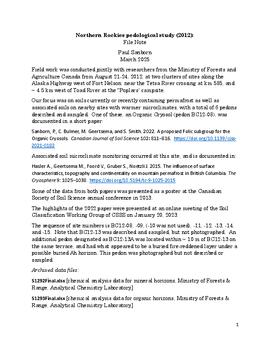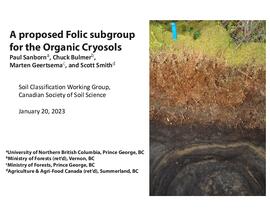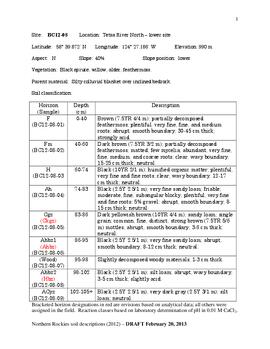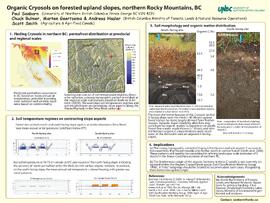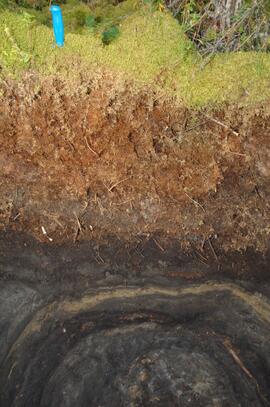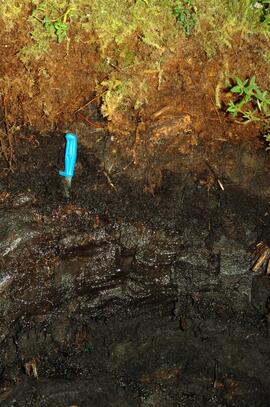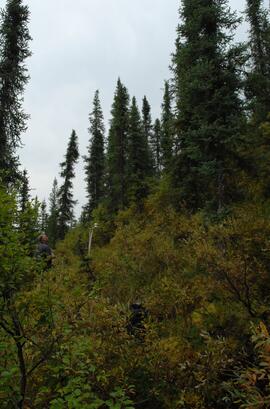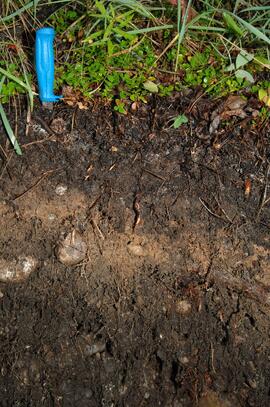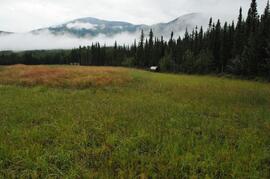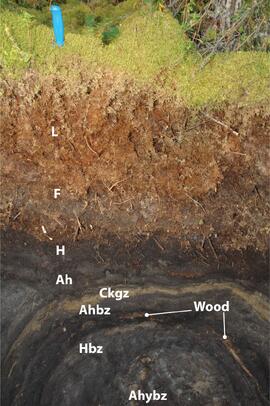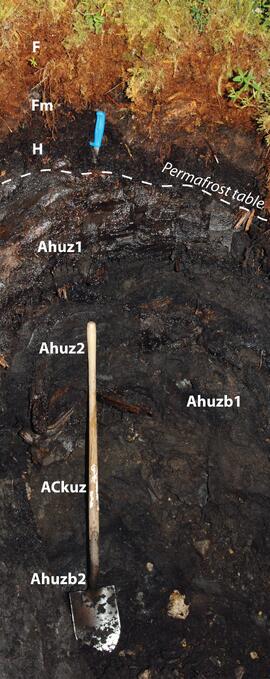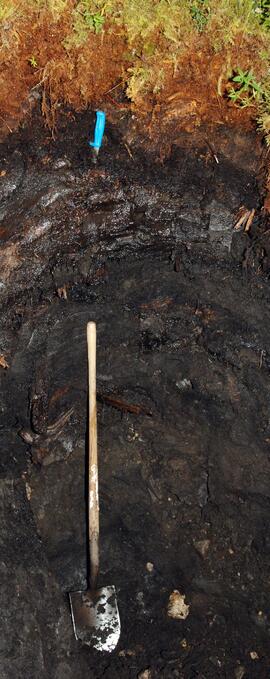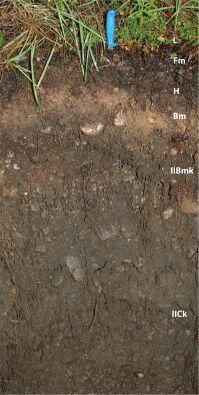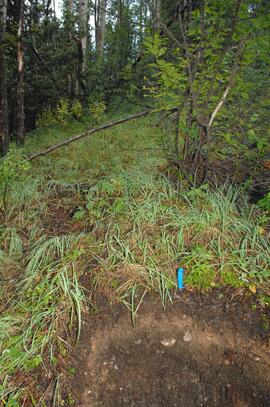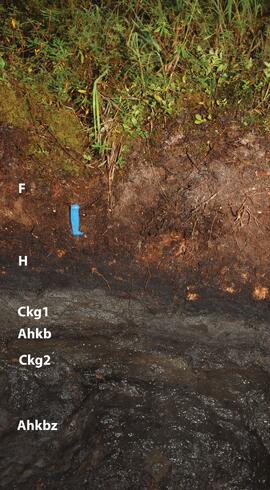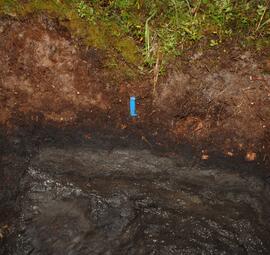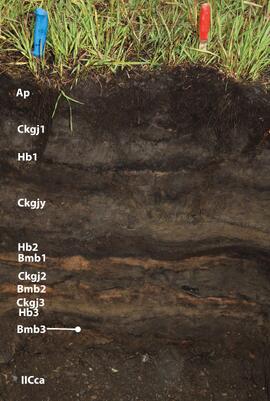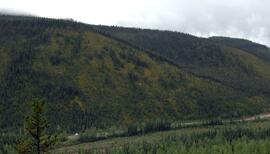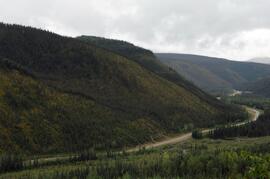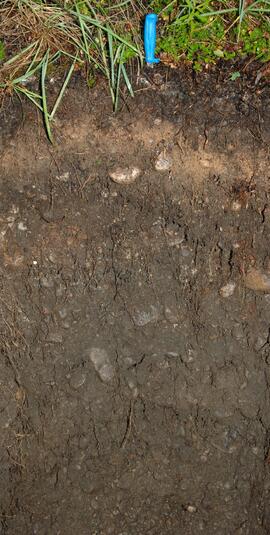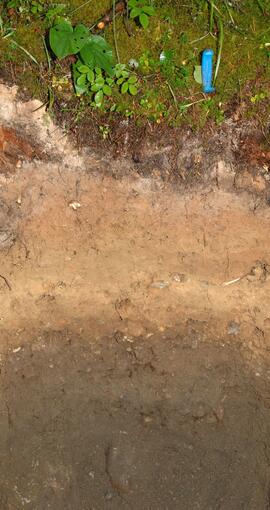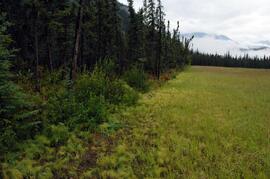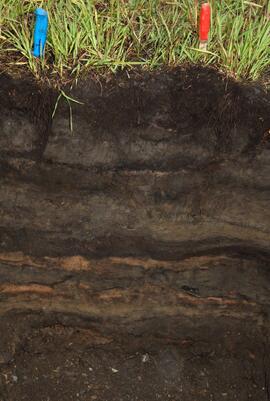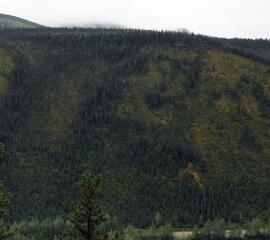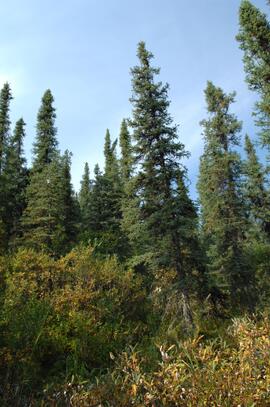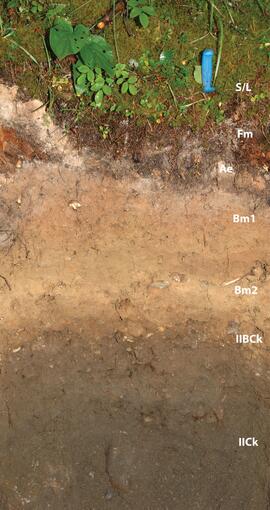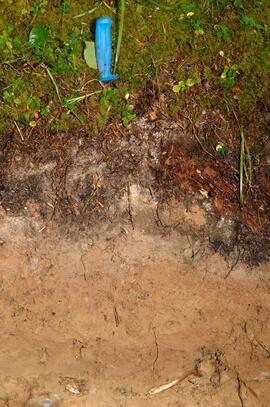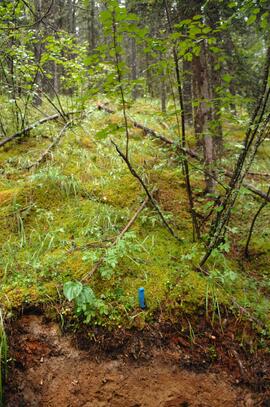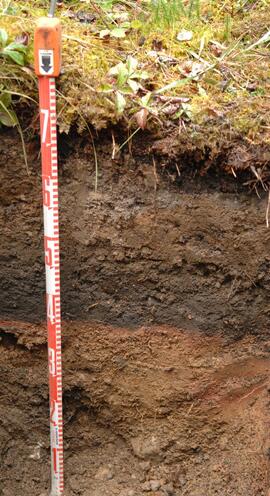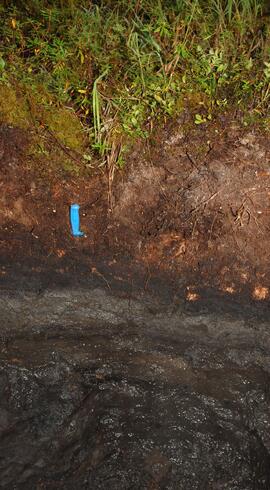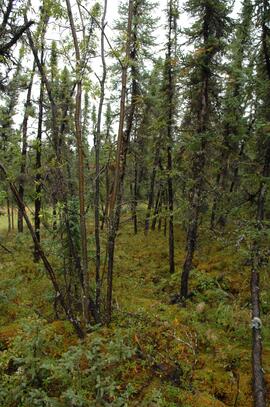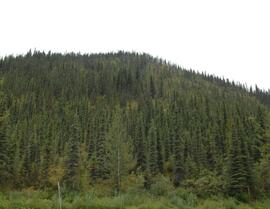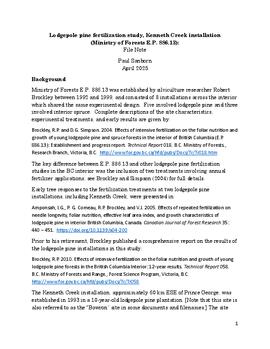Data set consists of lab data for sites Y04-01 to Y04-04. Original data set created in 2004; an update was provided in March 2023 but horizon designations were not updated to be consistent with the paper.
In July 2009, Dr. Paul Sanborn undertook the first soils field research at the Fort Selkirk volcanic field in central Yukon, with helicopter support and funding from the Yukon Geological Survey. This file includes the following data sets gathered from the research:
- Ft Selkirk 110114069.xls [particle size analysis data, CANTEST]
- S1090final.xlsx [chemical analysis data, Ministry of Forests & Range, Analytical Chemistry Laboratory]
- S1112final.xlsx [chemical analysis data, Ministry of Forests & Range, Analytical Chemistry Laboratory]
- Ft Selkirk 2009 soils data (updated Sept 15, 2010 and April 10, 2023).xls [consolidated lab data for all 2009 samples]
For July 1-7, 2009, Dr. Paul Sanborn did the first soils field research at the Fort Selkirk volcanic field in central Yukon, with helicopter support and funding from the Yukon Geological Survey.
Initial findings were published in the 2009 edition of Yukon Exploration and Geology, but this paper did not include most of the laboratory data:
Sanborn, P., 2010. Soil reconnaissance of the Fort Selkirk volcanic field, Yukon (115I/13 and 14). In: Yukon Exploration and Geology 2009, K.E. MacFarlane, L.H. Weston and L.R. Blackburn (eds.), Yukon Geological Survey, Whitehorse, Yukon. pp. 293-304. https://emrlibrary.gov.yk.ca/ygs/yeg/2009/2009_p293-304.pdf [Note that in Fig. 1, the labels for Camp 1 and Camp 2 on map are transposed; Camp 1 should be to the east of Camp 2.]
The Lost Chicken Mine, a placer gold mine in eastern Alaska, approximately 120 km west of Dawson City, Yukon, is an important fossil locality for the late Pliocene (approximately 2.5 – 3.0 million years ago). A comprehensive account of the stratigraphy and paleontology of this site was given by:
Matthews, J.V., Jr., J.A. Westgate, L. Ovenden, L.D. Carter, and T. Fouch. 2003. Stratigraphy, fossils, and age of sediments at the upper pit of the Lost Chicken gold mine: new information on the late Pliocene environment of east central Alaska. Quaternary Research 60: 9-18. https://doi.org/10.1016/S0033-5894(03)00087-5
Dr. Paul Sanborn visited the site on July 20, 2004, as part of a group led by Duane Froese (Professor, University of Alberta). The group concentrated on a single exposure (~ 2 m thick) straddling the Lost Chicken tephra, a volcanic ash bed (2.9 ± 0.4 myr) which is a major stratigraphic marker at the site. Sanborn described, photographed, and sampled this exposure, and obtained a basic set of characterization data. Intact samples were collected but thin sections were never produced.
For this Northern Rockies pedological study, Dr. Paul Sanborn conducted field work jointly with researchers from the Ministry of Forests and Agriculture Canada from August 21-24, 2012, at two clusters of sites along the Alaska Highway west of Fort Nelson: near the Tetsa River crossing at km 585, and ~4.5 km west of Toad River at the "Poplars" campsite.
The focus of the study was on soils currently or recently containing permafrost as well as associated soils on nearby sites with warmer microclimates, with a total of 6 pedons described and sampled. One of these, an Organic Cryosol (pedon BC12-08), was documented in a short paper:
Sanborn, P., C. Bulmer, M. Geertsema, and S. Smith. 2022. A proposed Folic subgroup for the Organic Cryosols. Canadian Journal of Soil Science 102: 811–816. https://doi.org/10.1139/cjss-2021-0182
Associated soil microclimate monitoring occurred at this site, and is documented in:
Hasler A., Geertsema M., Foord V., Gruber S., Noetzli J. 2015. The influence of surface characteristics, topography and continentality on mountain permafrost in British Columbia. The Cryosphere 9: 1025–1038. https://doi.org/10.5194/tc-9-1025-2015
Some of the data from both papers was presented as a poster at the Canadian Society of Soil Science annual conference in 2013.
The highlights of the 2022 paper were presented at an online meeting of the Soil Classification Working Group of CSSS on January 20, 2023.
The sequence of site numbers is BC12-08, -09, (-10 was not used), -11, -12, -13, -14, and -15. Note that BC12-13 was described and sampled, but not photographed. An additional pedon designated as BC12-13A was located within ~10 m of BC12-13 on the same terrace, and had what appeared to be a buried fire-reddened layer under a possible buried Ah horizon. This pedon was photographed but not described or sampled.
In July 2009, Dr. Paul Sanborn undertook the first soils field research at the Fort Selkirk volcanic field in central Yukon, with helicopter support and funding from the Yukon Geological Survey. This document is a complete transcription of field notes, with
soil and site photographs.
Presentation slides for the January 2023 meeting of the Soil Classification Working Group, Canadian Society of Soil Science
The Kluane Lake area of SW Yukon was a continuing focus of Dr. Paul Sanborn's research for more than a decade, and generated several productive collaborations. Key themes included biological soil crusts in boreal grasslands, and interactions between aeolian sediment deposition, slope processes, and fire in boreal grassland and forest soils.
Research results appeared in these publications:
Marsh, J., Nouvet, S., Sanborn, P., and Coxson, D. 2006. Composition and function of biological soil crust communities along topographic gradients in grasslands of central interior British Columbia (Chilcotin) and southwestern Yukon (Kluane). Canadian Journal of Botany 84: 717-736. https://doi.org/10.1139/b06-026
Pautler, B.G., Reichart, G.-J., Sanborn, P.T., Simpson, M.J., and Weijers, J.W.H. 2014. Comparison of soil derived tetraether membrane lipid distributions and plant-wax δD compositions for reconstruction of Canadian Arctic temperatures. Palaeogeography, Palaeoclimatology, Palaeoecology 404: 78-88. https://doi.org/10.1016/j.palaeo.2014.03.038
Sanborn, P. and A.J.T. Jull. 2010. Loess, bioturbation, fire, and pedogenesis in a boreal forest – grassland mosaic, Yukon Territory, Canada. 19th World Congress of Soil Science, Soil Solutions for a Changing World 1 – 6 August 2010, Brisbane, Australia. http://www.iuss.org/19th%20WCSS/Symposium/pdf/0120.pdf
The 2003 field work with Darwyn Coxson was a pilot study to assess the types and distribution of biological soil crusts in boreal grasslands in the Kluane Lake area. Eight sites were visited at which the team sampled the crust and the uppermost A horizon immediately underneath it. Note that site numbers Y03-03, -04, -05, -06, -07, -09, -10 and -12 were indicated as sites 3, 4, 5, 6, 7, 9, 10 and 12 in Table 1 of Marsh et al. (2006). Additional crust sampling was conducted at two additional sites (“Peninsula”, “Silver City”) in 2004; details of sampling methods and site locations are in Marsh et al. (2006).
Results from 2009 field work were presented in Sanborn and Jull (2010), along with soil charcoal radiocarbon dates from 2003-2008 sampling which were used to reconstruct fire history in the Kluane Lake area. The 2003 (a single site at Silver City), 2004, and 2008 field work consisted of a reconnaissance of grassland and forest sites across a range of aspects and slope positions in order to recover buried soil charcoal.
File consists of the following data sets:
- Kluane crust Min N (2003) S671FINL.xls [mineralizable nitrogen for biological soil crusts & upper mineral soil, 2003 samples]
- Kluane Crust samples (2004) moisture contents.xls [moisture content of air-dry 2004 crust samples from Peninsula & Silver City sites; sampling procedures & locations in Marsh et al. (20060]
- Kluane Soil Crusts (2004) chemical analyses.xls [consolidated file of chemical data for 2004 crust samples from Peninsula & Silver City sites]
- Kluane 2003 soil & crust 15N data.xls [15N natural abundance, total N, organic & inorganic C for 2003 crust & upper mineral soil samples]
- Kluane 2003 soil data.xlsx [consolidated file of chemical data for 2003 crust and mineral horizon soil samples]
- Kluane Crust 2004 total C & N data.xls
- Kluane AMS dates (2003-2008 charcoal samples).xls [radiocarbon dates from the University of Arizona Accelerator Mass Spectrometry Lab]
- Kluane soil transect - texture data.xls [2009 soil particle size analysis data, with potential lithological breaks highlighted]
- Kluane surveys 2009.xls [topographic surveys for 3 soil transects cutting across eskers along Cultus Bay Rd., SE shore of Kluane L.]
- S1061_1069_Final_Rev1.xls [lab data report from Ministry of Forests Analytical Chemistry Laboratory for 2009 transect samples: total C, inorganic C, & total N]
- 100812003 (annotated) -corrected.xls [2009 transect samples: particle size analysis data report from CANTEST]
- Kluane soil transect - master data file.xls
File contains the following data sets:
- S1292Final.xlsx [chemical analysis data for mineral horizons, Ministry of Forests & Range, Analytical Chemistry Laboratory]
- S1293Final.xlsx [chemical analysis data for organic horizons, Ministry of Forests & Range, Analytical Chemistry Laboratory]
- B299530-R2013-02-18_15-47-21_N001.xls [particle size analysis data for mineral horizons, Maxxam Laboratories]
- B299530-R2013-02-18_15-47-21_R014.pdf [particle size analysis data for mineral horizons, Maxxam Laboratories]
- Northern Rockies 2012 sample list - Maxxam.xls [list of samples submitted to Maxxam Laboratories for particle size analysis; indicates which samples needed carbonate removal pretreatment]
- N Rockies 2012 - master data file.xlsx [working copy of combined chemical and particle size data in report format]
Poster presentation at 2013 Canadian Society of Soil Science Conference
Image is a panoramic view of north-facing slope (sites BC12-08 and BC12-09) overlooking the Tetsa River crossing of the Alaska Highway, taken from across the valley.
Image is a panoramic view of north-facing slope (sites BC12-08 and BC12-09) overlooking the Tetsa River crossing of the Alaska Highway, taken from across the valley.
Image is a panoramic view of north-facing slope (sites BC12-08 and BC12-09) overlooking the Tetsa River crossing of the Alaska Highway, taken from across the valley.
Image is a panoramic view of north-facing slope (sites BC12-08 and BC12-09) overlooking the Tetsa River crossing of the Alaska Highway, taken from across the valley.
Forest soil sulphur research was a continuing interest for Dr. Paul Sanborn for more than 30 years, beginning at UBC in the mid-1980s when he took a graduate course in Forest Soils from Dr. Tim Ballard. Among the things that he learned was that soils in much of BC were deficient in sulphur (S). Simultaneously, he became aware of the large amount of research on prescribed fire in BC forests, with broadcast burning being the main method of site preparation across much of the province at that time.
Sanborn undertook various projects in this area of research:
- UBC Postdoctoral Project on effects of prescribed fire on sulphur in forest soils (1988-90)
- Cluculz retrospective study (E.P. 886.10) with the BC Ministry of Forests and UNBC
- Sulphur stable isotope tracer study (E.P. 886.15) with the BC Ministry of Forests and UNBC
Document is a research installation layout map for the Kenneth Creek site of the Sulphur stable isotope tracer study (E.P. 886.15).
With the assistance of the Yukon Geological Survey, Dr. Paul Sanborn was able to visit the terminus of the Klutlan Glacier, a major outlet glacier which originates in the Alaska portion of the St. Elias Mountains. The stagnant terminus has a thick cover of debris, including a large component of White River tephra, providing enough soil material to support a boreal forest. Field work occurred on July 8, 2007, and results were published as:
Sanborn, P. 2010. Soil formation on supraglacial tephra deposits, Klutlan Glacier, Yukon Territory. Canadian Journal of Soil Science 90: 611-618. https://doi.org/10.4141/cjss10042
Data sets for the Sulphur stable isotope tracer study (E.P. 886.15) include:
- 03-095 UNBC PS-For.xls Particle size analyses (Kenneth Creek 0-20 & 20-40 cm)
- 03-096 UNBC PS-For.xls Particle size analyses (Holy Cross 0-20 & 20-40 cm)
- 082037.xls XRF elemental analysis (Holy Cross pedon)
- 082038.xls XRF elemental analysis (Kenneth Creek pedon)
- 084996.xlsx XRF elemental analysis (HC & KC parent materials)
- EP 886 15 S isotope data (2001-2005) - foliage_completed (Feb 18).xls Pine foliage d34S (total S & total SO4-S)
- EP 886.15 2003 Foliage & Soil Chemistry Summary.xls
- EP 886.15 Foliar Analyses (selected) 2001-2006.xls Total N & S, SO4-S
- EP 886.15 Holy Cross & Kenneth Creek 2005 foliage.xls
- EP 886.15 Holy Cross & Kenneth Creek 2006 foliage.xls
- EP 886.15 Holy Cross 2001 FH (S516FINL).xls
- EP 886.15 Holy Cross 2001 Foliage (T727FINL).xls
- EP 886.15 Holy Cross 2001 Litter (S515FINL).xls
- EP 886.15 Holy Cross 2001 Mineral Soil (0-20 cm) (S507FINL).xls
- EP 886.15 Holy Cross 2002 Foliage (T785FINL).xls
- EP 886.15 Holy Cross 2003 FH (S642FINL).xls
- EP 886.15 Holy Cross 2003 Foliage (T836FINL).xls
- EP 886.15 Holy Cross 2003 Litter (S641FINL).xls
- EP 886.15 Holy Cross 2003 Mineral Soil (0-20 cm) (S643FINL).xls
- EP 886.15 Holy Cross 2004 FH (S702FINL).xls
- EP 886.15 Holy Cross 2004 Foliage (T904FINL).xls
- EP 886.15 Holy Cross 2004 Litter (S701FINL).xls
- EP 886.15 Holy Cross 2004 Mineral Soil (0-20 cm) (S703FINL).xls
- EP 886.15 Kenneth Creek 2001 FH (S521FINL).xls
- EP 886.15 Kenneth Creek 2001 Foliage (T727FINL).xls
- EP 886.15 Kenneth Creek 2001 Litter (S520FINL).xls
- EP 886.15 Kenneth Creek 2001 Mineral Soil (0-20 cm) (S508FINL).xls
- EP 886.15 Kenneth Creek 2001 Mineral Soil (20-40 cm) (S509FINL).xls
- EP 886.15 Kenneth Creek 2002 Foliage (T785FINL).xls
- EP 886.15 Kenneth Creek 2003 FH (S645FINL).xls
- EP 886.15 Kenneth Creek 2003 Foliage (T837FINL).xls
- EP 886.15 Kenneth Creek 2003 Litter (S644FINL).xls
- EP 886.15 Kenneth Creek 2003 Mineral Soil (0-20 cm) (S646FINL).xls
- EP 886.15 Kenneth Creek 2003 Mineral Soil (20-40 cm) (S647FINL).xls
- EP 886.15 Kenneth Creek 2004 FH (S705FINL).xls
- EP 886.15 Kenneth Creek 2004 Foliage (T905FINL).xls
- EP 886.15 Kenneth Creek 2004 Litter (S704FINL).xls
- EP 886.15 Kenneth Creek 2004 Mineral Soil (0-20 cm) (S706FINL).xls
- EP 886.15 Kenneth Creek 2004 Mineral Soil (20-40 cm) (S707FINL).xls
- EP 886.15 Sample Inventory.xls Listing of MoF Lab Job No.'s
- Fertilizer March 2003.xls d34S data for commercial fertilizer S sources
- hc_2002.xls Initial (2002) pine tree measurement data - Holy Cross
- kc_2002.xls Initial (2002) pine tree measurement data - Kenneth Creek
Document is a research installation layout map for the Holy Cross Creek site of the Sulphur stable isotope tracer study (E.P. 886.15).
Ministry of Forests E.P. 886.13 was established by silviculture researcher Robert Brockley between 1992 and 1999, and consisted of 8 installations across the interior which shared the same experimental design. Five involved lodgepole pine and three involved interior spruce. Complete descriptions of the site characteristics, experimental treatments, and early results are given by:
Brockley, R.P. and D.G. Simpson. 2004. Effects of intensive fertilization on the foliar nutrition and growth of young lodgepole pine and spruce forests in the interior of British Columbia (E.P. 886.13): Establishment and progress report. Technical Report 018. B.C. Ministry of Forests., Research Branch, Victoria, B.C. http://www.for.gov.bc.ca/hfd/pubs/Docs/Tr/Tr018.htm
The key difference between E.P. 886.13 and other lodgepole pine fertilization studies in the BC interior was the inclusion of two treatments involving annual fertilizer applications; see Brockley and Simpson (2004) for full details.
Early tree responses to the fertilization treatments at two lodgepole pine installations, including Kenneth Creek, were presented in:
Amponsah, I.G., P. G. Comeau, R.P. Brockley, and V.J. 2005. Effects of repeated fertilization on needle longevity, foliar nutrition, effective leaf area index, and growth characteristics of lodgepole pine in interior British Columbia, Canada. Canadian Journal of Forest Research 35: 440 – 451. https://doi.org/10.1139/x04-200
Prior to his retirement, Brockley published a comprehensive report on the results of the lodgepole pine installations in this study:
Brockley, R.P. 2010. Effects of intensive fertilization on the foliar nutrition and growth of young lodgepole pine forests in the British Columbia Interior: 12-year results. Technical Report 058. B.C. Ministry of Forests and Range., Forest Science Program, Victoria, B.C. http://www.for.gov.bc.ca/hfd/pubs/Docs/Tr/Tr058
The Kenneth Creek installation, approximately 60 km ESE of Prince George, was established in 1993 in a 10-year-old lodgepole pine plantation. [Note that this site is also referred to as the "Bowron" site in some documents and filenames.] The site was located on a flat glacial outwash terrace with fairly uniform deep sandy soils, and was extensive enough that it later hosted one of two installations of E.P. 886.15 established in 2001. (See https://search.nbca.unbc.ca/index.php/2023-2-2-1-3.) The Kenneth Creek site was attacked by mountain pine beetle in 2006, resulting in at least 80% tree mortality. In 2013, the stand was levelled in order to enable replanting.
Dr. Paul Sanborn's involvement in this study addressed three aspects of soil and nutrient cycling responses to the fertilization treatments:
- mineral soil and forest floor nutrient stocks, (Sub-subseries 2023.2.2.15.1)
- litterfall amounts and chemical composition, and, (Sub-subseries 2023.2.2.15.2)
- litter decomposition. (Sub-subseries 2023.2.2.15.3)
During the 1980s, Agriculture Canada pedologists Scott Smith (retired from Summerland Research Station, formerly based in Whitehorse) and Charles Tarnocai (retired from Central Experimental Farm, Ottawa) had a large field program which addressed the trends in soil development in the central Yukon. Across this region, particularly between Whitehorse and Dawson City, the land surfaces and surficial deposits vary greatly in age due to the differing extents of glaciations over the past ~2 million years.
This work built on a pioneering study from the previous decade:
Foscolos, A.E., N.W. Rutter, and O.L. Hughes. 1977. The use of pedological studies in interpreting the Quaternary history of central Yukon Territory. Bulletin 271. Geological Survey of Canada, Ottawa. 48 p. https://doi.org/10.4095/103066
Tarnocai and Smith presented their results in two publications:
C. A. S. Smith, C. Tarnocai, and O. L. Hughes. 1986. Pedological investigations of Pleistocene glacial drift surfaces in the central Yukon. Géographie physique et Quaternaire, 40 (1): 29–37. https://doi.org/10.7202/032620ar
Tarnocai, C. and C. A. S. Smith. 1989. Micromorphology and development of some central Yukon paleosols, Canada. Geoderma 45 (2): 145-162. https://doi.org/10.1016/0016-7061(89)90047-5
Tarnocai and Smith shared the unpublished data and soil samples from this work with Dr. Paul Sanborn, and this resulted in a student project published as:
Daviel, E., P. Sanborn, C. Tarnocai, and C.A.A. Smith. 2011.Clay mineralogy and chemical properties of argillic horizons in central Yukon paleosols. Canadian Journal of Soil Science 91: 83-93. https://doi.org/10.4141/cjss10067
This data set consists of elemental analysis data for selected B horizons from Wounded Moose paleosols sampled by Tarnocai and Smith. The file includes the original ALS lab report, additional panes showing comparison of replicates, and calculation of a weathering index.
The following Excel files are the primary lab reports from the Ministry of Forests analytical laboratory. At the time of this study, the lab reports would only use a minimal sample identification consisting of a sequential number (1, 2 … etc.) for each sample in a job. The submitter had to maintain their own records to link that sequential number in the report to something more meaningful – in this case, the tag number on the litterbag, the litter type, and the plot number – as recorded in my consolidated file Kenneth Creek Litterbag Sample Numbering.xlsx
- T458FINL.xls [Most of the data in this file – samples 7-31 – are for litter trap samples in the fall 1997 collection, but the first 6 are triplicate analyses of the initial pine needle litter materials used in the litterbags: #1-3 are Control, and #4-6 are ON2.]
- T483FINL.xls [Litterbags recovered May 5, 1998]
- T508FINL1.xls [Samples 19-42 are from the Kenneth Creek litterbags, recovered Oct. 20, 1998; samples 1-18 are from the EP 1148 (Bobtail) litterbag experiment, recovered Oct. 1998]
- T551FINL.xls [Litterbags recovered April 30, 1999]
- T589F.xls [Litterbags recovered October 12, 1999]
- T613FINL.xls [Litterbags recovered May 4, 2000]
- T650FINL.xls [Litterbags recovered October 11, 2000]
- T700FINL.xls [Litterbags recovered September 27 – October 5, 2001]
- T765FINL.xls [Litterbags recovered September 21, 2002]
- T830FINL.xls [Litterbags recovered October 15, 2003]
- T901FINL.xls [Litterbags recovered October 1, 2004]
Two files contain the complete records of initial litter materials and recovered litterbag contents, with some limited summaries of mean values by treatment and recovery date:
- BowDcomp.xls [complete record of weights of recovered litterbag contents in “Raw Data” tab]
- Bowron Litterbag Chemistry (update Aug 2010).xls [complete compilation of chemical analyses of initial and recovered litterbag materials]
